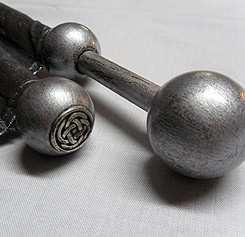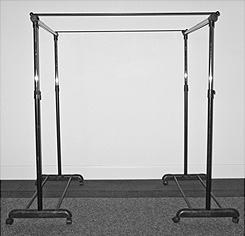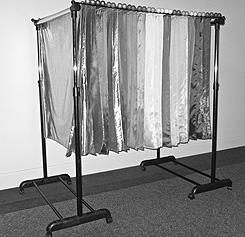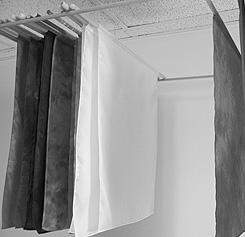FACTS ABOUT FLAG SILK
We use 100% Natural Habotai Silk in most of our products that are hand dyed. If you order a white undyed flag, you will see that natural silk is white but not bright white because it is not bleached; it is a natural fiber. We begin with natural white silk and use Fiber Reactive and other dyes to bring about colors and patterns that symbolize the message we want to convey. As you can see, hand dyed silks do not have the regularity of commercially dyed fabrics. When two pieces of silk are hand dyed with the same dyes, they will still look different. Silk dyers are generally pleased with naturally occurring variations and 'imperfections' in their work, such as dye specks, water spots, color separations, etc. The silk piece is considered more beautiful when it has a lot of 'action' going on. These unique markings give the silk its special appeal and are a sign that your item has been created by an artist's hand.
WHAT TO DO WHEN YOUR FLAG HAS STATIC ELECTRICITY
Sometimes you will find your flags clinging because of static electricity. Silk and polysilk are especially prone during cold, dry weather. We have found it safe to spray the flags with the product, Static Guard. The flags should not be saturated with the spray, which would be unnecessary. Just a light spray standing a few feet from the flag will work.
WAYS FLAGS ARE USED IN WORSHIP WARFARE
There are a variety of effects that flags bring to worship. One is as weapons of war. How is a flag used in worship warfare? What real effect can it have in spiritual battle? How is it a weapon? Are flags symbolic swords? Following are a few answers to these questions.
FLAGS FOR IDENTIFICATION
According to Scripture, Israel's flags (standards, ensigns) existed as identification for the tribes (armies) of God. "And the children of Israel shall camp every man by his troops and bands and army." (Num 1:52 DRA) "The children of Israel shall encamp every man by his own standard, with the ensigns of their father's houses." (Num 2:2 ASV)
Historically, battle flags identified a country and the ruler of its army. If the country and king had a reputation for being powerful, just the sight of the flags approaching for battle instilled fear in their enemies. Once the enemy was weakened, he was vulnerable to defeat. In this way, the flag was a "weapon" that destroyed resistance. This principle can apply to spiritual warfare: God's enemies tremble when they see the flags of his armies. "His young men will become subject to forced labor . . . by reason of terror, and his princes will be afraid of the banner of Israel, says the Lord, whose fire is in Zion, and his furnace in Jerusalem." (Is 31:8-9) "Lord, the God of our fathers, aren't you God in heaven? Aren't you ruler over all the kingdoms of the nations? Power and might are in your hand, so that no one is able to withstand you." (2 Chron 20:6 WMB)
FLAGS OF PRAISE
Flags are brought into battle on the front lines. When they are used as instruments of worship and praise, it is like Jehoshaphat's army where those who praised the Lord went out first in the battle. God caused Israel's enemies to be defeated with only that one act. Not with the sword, but with words and actions of praise the enemy was overthrown. "Do not be afraid. Neither should you be dismayed by this multitude. For the fight is not yours, but God's. And he (Jehoshaphat) appointed those who should sing to Yahweh, and give praise in holy array, as they went out before the army. When they began to sing and to praise, Yahweh set ambushes against the children of Ammon, Moab, and Mount Seir, who had come against Judah; and they were struck down." (2 Chron 20:15,21-22 CPDB & WEB)
SWORD OF WAR
There were swords present in many ancient battles. According to Scripture, in spiritual warfare the sword is the word of God. "Out of his mouth proceeds a sharp, double-edged sword, that with it he should strike the nations." (Rev 19:15 WEB) "For the word of God is living and active, and sharper than any two-edged sword, piercing even to the dividing of soul and spirit, of both joints and marrow." (Heb 4:12 WEB) If your flag conveys a Scripture or its design and/or colors symbolize the Word of the Lord, in that way it could be considered a weapon of war like a spiritual sword.
Although a worship flag can be thought of as a symbolic sword; practically speaking, it doesn't work well to use it like a real sword. Flags are made with lightweight and somewhat delicate fabrics so that they can float and wave. Actual swords are made of metal that can withstand violent use. Swords are brandished: Flags are waved. Definitions for wave imply smooth or continuous motion and graceful movement; whereas, brandish implies an aggressive manner as with a weapon or whip. "Let them praise his name in the dance! . . . May the high praises of God be in their mouths, and a two-edged sword in their hand." (Ps 149:3,7 WEB) "Their kings shall be terribly afraid . . . They shall shudder with terror when I brandish my sword before them." (Ez 32:10 ASV) To keep your flags in usable condition, it's best not to try to whip them around like an actual sword.
HOW TO SHOW PROPER RESPECT
Countries have rules for treating their flags with respect. There are federal laws relating to the use of the United States flag (United States Code Title 4 Chapter 1 - The Flag). Some of those rules can be appropriately applied to the use of flags that represent the King of kings and his kingdom. For example:
"No disrespect should be shown to the flag of the United States of America."
"The flag should never touch anything beneath it, such as the ground, the floor, water, or merchandise."
"The flag should never be fastened, displayed, used, or stored in such a manner as to permit it to be easily torn, soiled, or damaged in any way."
"The flag represents a living country and is itself considered a living thing. Therefore, the lapel flag pin being a replica, should be worn on the left lapel near the heart."
"The flag, when it is in such condition that it is no longer a fitting emblem for display, should be destroyed in a dignified way, preferably by burning."
All of the rules for the U.S. flag may not apply to worship flags, but we can learn from them. If it is proper protocol for earthly national flags to be treated respectfully, then similar and even greater respect is due to the flags of the Lord of heaven's armies.
SCRIPTURES:
"Set up a banner on the bare mountain! . . . The Lord of Hosts is mustering the army for the battle. They come from a far country, from the uttermost part of heaven." (Is 13:2,4-5 WMB) "Who is this King of glory? Yahweh of Armies is the King of glory!" (Ps 24:10 WEB)
HOW TO CHOOSE A FLAG SIZE
Thoughts on Classic style Worship Flags, Semi-circles with wood rods, and tall Praise Banners.
The proper size for these flags will probably have more to do with the size of the worship space rather than the size of the worshiper. Some shorter people prefer very large flags and tall people can prefer small flags. [Even small children have enjoyed using the tall flags on eight-foot poles; but usually find the extra large Classic flags cumbersome.]
It's generally better for 3 yr to 8 yr old children (or according to the child's height and strength) to use the small and medium worship flags and small semi-circle flags. Adults can use any size flag they find comfortable as long as it will fit in the space available. For some small apartments and very small church spaces, it might be best to choose the small or medium flags. If a dance team will be using the flags and they will be moving close to each other, medium or large worship flags work very well. They are large enough to be showy from a distance, but compact enough to allow dancers to remain close together. If the team has a spacious area in which to dance, the extra large size worship flags might be preferred. The tall flags (Praise Banners on 8 ft poles) rise above everyone's head so they fit in small areas; but they need high ceilings with no obstacles hanging down (like sound equipment, lights, and ceiling fans.)
Sometimes people will simply look more appropriate using flags in proportion to their bodies. A small flag in the hand of a six foot person can become lost; whereas, an extra large flag would look more suitable. We strongly suggest if you are not certain about the size you're thinking of buying, that you use a yardstick to lay out the measurements and get a good picture of the flag's size before you order. This will assure that you are satisfied with your purchase.




